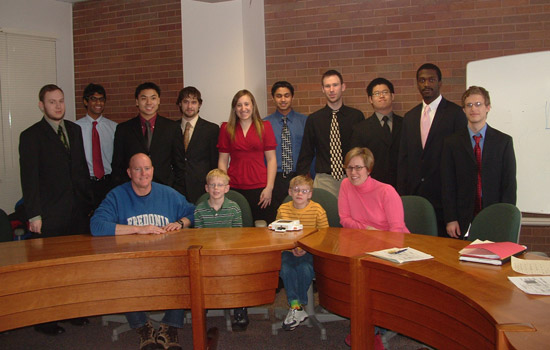Interactive game for visually impaired child wins student design award
RIT undergraduates develop teaching game designed for 9-year-old
J. Muszynski
Members of the RIT senior design team are congratulated by the Fortner family of Rochester. The team designed an interactive game for their son, Luke, that won the 2009 IEEE Student Design Award. (Front row) Mike Fortner, Jack Fortner, Luke Fortner, Cindy Fortner (Back Row) Jesse Muszynski, Ketan Surender, Christopher Yang, Nick Babin, Alana Malina, Neil Pinto, Robert Modzelewski, Pei Hong Tan, Claude Jerome, David Carmichael
Students from Rochester Institute of Technology designed and built an interactive game for a visually impaired 9-year-old that entertained and educated as well as won first place in the 2009 Institute of Electrical and Electronics Engineers Student Design Awards contest this past summer.
The multidisciplinary team from RIT was awarded $5,000 for the small, rechargeable, battery powered, hand-held device it built. Students incorporated an LCD display, tactile feedback motors, stereo speakers and a simple user interface to build a model that was both fun and focused on a 9-year-old’s sensory development.
Two years ago, a local physician, Dr. Julie Lenhard of Perinton Pediatrics, contacted RIT to design and build a handheld game to help a patient with a visual impairment, says Jesse Muszynski,a sixth-year electrical engineering student and member of the RIT IEEE student chapter. The child recognized shadows, lights and color but had difficulty reading a book. The purpose of the game was to offer entertainment during office visits as the doctor and parents discussed the child's progress.
The handheld device consists of a series of oversized ‘action’ buttons, an analog volume control with a headphone jack and a power button. The child can select a series of games developed by the team by inserting separate game cartridges of a maze, an avoidance game or a modified version of the popular video game, Simon.
“The team’s success can be attributed to the diversity of its members,” says Muszynski. “It was truly a multidisciplinary group because of all the majors involved.”
The undergraduate students involved in the winning design project are Christopher Yang, Nick Babin, Alana Malina, Ketan Surender, Neil Pinto and Muszynski from the Kate Gleason College of Engineering; Robert Modzelewski and Pei Hong Tan from the College of Imaging Arts and Sciences; and David Carmichael and Claude Jerome from the Golisano College of Computing and Information Sciences.
“This team quickly applied their knowledge and were engaged from start to finish in developing this game for Luke, the child,” says George Slack, lecturer, electrical and microelectronic engineering departments, who supervised the design project. “They worked patiently with Luke to better learn his needs, developed multiple concepts, performed frequent revisits to test their prototype ideas and finally completed a very sophisticated design which proved to be extremely innovative with the reliability of a finished product.”
This was the ninth annual design contest sponsored by Fairchild Semiconductor, RIT’s Department of Electrical Engineering and regional chapters of the IEEE, the international, professional organization that supports advances in engineering, computing and informational technologies. Funding for the design portion of the RIT project came from a grant from the National Science Foundation.







